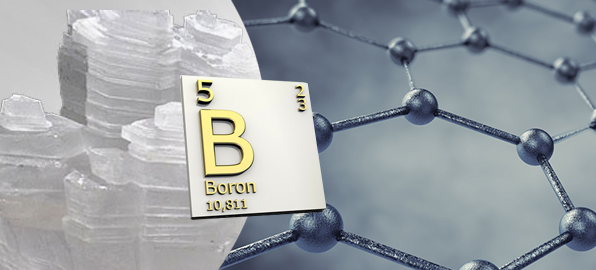
Boron is the chemical element with the chemical symbol and the atomic number 5 in the Periodic System. It is neither metal (iron, copper, gold etc.) nor non-metal (oxygen, carbon, phosphor etc.) Boron is a so-called “Metalloid” (semi-metal) like silicium or germanium. Therefore its physical and chemical properties cannot be distinctly characterized as metallic or non-metallic.
Boron belongs to 13th group of the periodic System along with aluminium, gallium, indium and thallium. All elements of this group have 3 valence electrons. Elements with less than four valence electrons normally crystallize to metal lattices except boron, which does not form free ions with the charge +3. Boron atoms have 3 valence electrons and 4 valence orbitals. They prefer covalent bonds due to the high ionization energy and electronegativity. The unique but complicated lattice structures of the boron modifications (crystal forms) follow from this electron deficit of the boron atoms. Boron never exists in pure form in nature due to the large affinity to oxygen. The instable pure boron has 4 allotrope modifications besides the amorphous form. That is, boron can take on 4 different crystal forms in the same state of aggregation. Another example of such a behavior is the 2 allotrope modifications (graphite and diamond) of the element carbon.
No other element shows a similar flexibility in its modifications. Boron atoms have coordination numbers ranging from 4 to 9 with highly varying bond gaps. Since boron atoms have merely 3 valence electrons, the large coordination numbers can only be achieved by formation of multiple-center bonds. These multiple-center bonds yield boron modifications possessing extreme hardness.
The thermodynamic stable b-rhombohedral boron has a Mohs hardness of 9.3 and is the second- hardest material after the carbon modification diamond with a Mohs hardness of 10. Other materials based on boron with large hardness are the black shiny boron carbides such as B13C2 or the cubic boron nitride CBN. In contrast, the hexagonal boron nitride Hbn is often used as high-temperature lubricant.
The 5 crystal modifications of pure boron are
· amorphous (brown powder)
· a-rhombohedral (red, translucent)
· b-rhombohedral (black-gray, shiny)
· a-tetragonal (black)
· b-tetragonal (red)
Important boron modifications containing foreign atoms are
· boron carbide B24C (tetragonal boron carbide)
· boron carbide B13C2 (a-rhombohedral boron carbide)
· hexagonal boron nitride (a-boron nitride)
· cubic nitride (b-boron nitride)
Boron is extremely heat-resistant, has a small density and a very high melting and boiling temperature. The electrical conductivity is very low at a temperature of 20° C (room temperature), but it increases tremendously when temperatures rise. At a temperature of 600° C, the electrical conductivity is hundred times more than at room temperature. Boron has the highest tensile strength of all known elements. Boron is translucent to infrared light.
